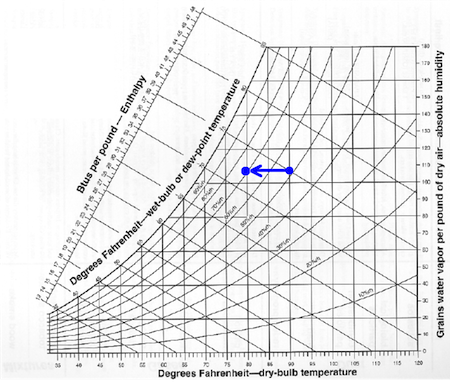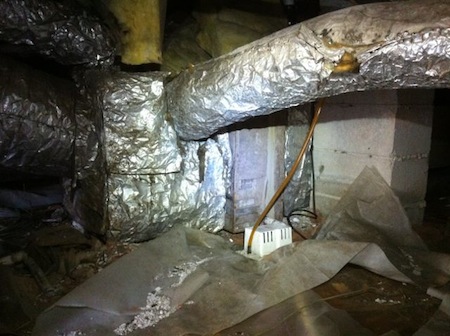Vented Crawl Spaces and the Psychrometric Chart Are Not Friends

Really, the argument about whether you should vent a crawl space in a humid climate is over. Advanced Energy’s research project from 2002 proved that closed crawl spaces outperform vented crawl spaces. A quick look at the psychrometric chart shows that the argument should never have existed in the first place.
I know it’s a bit hard to read, but if you click the image, you can see an enlarged version.
What’s going on here is that we’re starting at the blue dot to the right of the arrow. It’s a summer day, the outdoor temperature is 90° F and the relative humidity (RH) is about 53%. I chose that RH because here in Atlanta, we have a good number of hours with the dew point at about 70° F. By looking all the way to the left of the chart, where the relative humidity is 100%, you can read the dew point.
The point of that blue dot is that when that air comes into the crawl space, it cools down. I chose 80° F as the temperature it reaches in the crawl space. By looking at the relative humidity curve it lands on, you can see that it went from 53% to about 70% RH.
That is NOT a good number to keep your RH at because it’s where mold can start taking off. The more time your crawl space spends at 70% RH or higher, the more likely you are to have mold growing.

Vented crawl spaces can also get cooler than 80° F. I took the photo of the hygrometer above on a warm August day here in the Atlanta area, and you can see that the air was about 70° F with 92% RH.
And then there’s the evidence, of course. If you’ve spent any time in vented crawl spaces, you know—and your lungs and nose know—that they have problems. The photo below is from one I was in last month. Duct leakage exacerbates the problem here.

You can’t just seal up every crawl space you see, however. If it has atmospheric combustion appliances, you need to deal with that first. For the best guidance on how to do this right, go to crawlspaces.org, Advanced Energy’s website on the subject, and download their 75 page pdf file.
Related Articles
Dew Point — A More Meaningful Measure of Humidity?
The Medical Doctor, the HVAC Guy, & the Crawl Space
3 Reasons Your Crawl Space Has High Humidity & Grows Stuff
This Post Has 10 Comments
Comments are closed.

+1 on crawlspaces.org. There
+1 on crawlspaces.org. There are a few traps here, especially in new construction, so beware. There are plenty of important details but my main warnings would be:
1. For new construction, track wood moisture content & take measures when it starts getting above 15% or so.
2. After the crawl is closed, supply the crawl with an RH sensor with an alarm set for 75%.
3. What ever you do, don’t forget to communicate with the pest control contractor (trust me on this one;)
Thanks for pointing out that
Thanks for pointing out that this is for HUMID climates. At the ACI NW conference in Seattle this year, David Hales from Washington State University shared studies comparing vented, sealed and conditioned crawlspaces in the Pacific NW. Due to our climate conditions, the vented crawlspaces actually performed well (as long as they are properly ventilated). And on a cost/benefit basis can outperform sealed and even conditioned crawls.
While there may still be reasons to seal and/or condition crawl spaces in the NW from time-to-time, vented crawls are perfectly acceptable here. Unless of course there are water problems in them, but that is another topic altogether!
Good stuff Allison. The study
Good stuff Allison. The study on the Advance Energy page points out a interesting phenom for cold dry climates “While moisture reduction was consistent, energy
savings varied with climate, insulation and duct
placement. The research makes it evident that in cold climates, it’s better to insulate the floor
above the closed crawl space than to insulate the foundation walls.”
Good stuff!!
SO in my mixed climate, humid but shorter cooling season and longer drier heating season, what is the best solution?
OMG, all my firmly held
OMG, all my firmly held beliefs are being shaken! If I walk out the door, will the sky fall on me?
Next you’ll tell me my mother was wrong about washing in hot water to sanitize the laundry!
YOU DOGMA CRUSHER!! (Keep up the good work!)
I’ve sealed my crawlspace
I’ve sealed my crawlspace (mostly), and I installed a dehumidifier just to be sure it stayed dry. I don’t think it runs often, and it feels dry, and there is no mold growth, but I don’t like to depend on a dehumidifier. Any suggestions? (From Greenville, SC)
The other common option is to
The other common option is to supply air from the HVAC system. 1 cfm/30 sq.ft. Unless it’s really well sealed we find that this option does not work so well.
From above:
“After the crawl is closed, supply the crawl with an RH sensor with an alarm set for 75%.”
You should see RH levels in the 60’s in the summer. The alarm will alert you before any problems from the dehumidifier failing (which it will at some point).
Jeremy wrote: <
Jeremy wrote:
“in my mixed climate, humid but shorter cooling season and longer drier heating season, what is the best solution?”
In your climate, a basement would be best (in my opinion). But for crawls, the joist cavities should be insulated, and the perimeter sealed based on accepted design practice and local codes.
AE’s original research on closed crawls was conducted in eastern NC where the trade-off favors insulated walls. As you move further north, the trade-off begins to favor floor insulation. At what point cannot readily be modeled. It depends not only on climate but the relative cost of heating vs. cooling BTU’s, and whether HVAC is in the crawl. Also, the difficulty/cost of properly insulating the floor cavities is a factor.
AE’s follow-up study did little to clarify these trade-offs other than to raise the issue.
Although crawl spaces are easier for the trades, I’d rather have an edge-insulated on-grade slab in a warm climate. It’s not only more efficient (love that mass) but costs less to build. Either way, vented crawls are an abomination in humid climates.
By and large, I view a
By and large, I view a dehumidifier as a bandaid for building science compromises – expensive to run and must be maintained.
Better be sure any insulation applied in a crawl has provision for termite tunnel inspection; in other words, don’t give termites a place to hide their work.
With psychrometric chart
With psychrometric chart software you can calculate the dehumidifier capacity for your own situation. Have a look for the software at psychrometricchart.net
Recently I wrote an
Recently I wrote an application which makes calculations with psychrometric chart very easy. I thought it might be useful for you guys as well. You can download it for free at psychrometricchart.net.